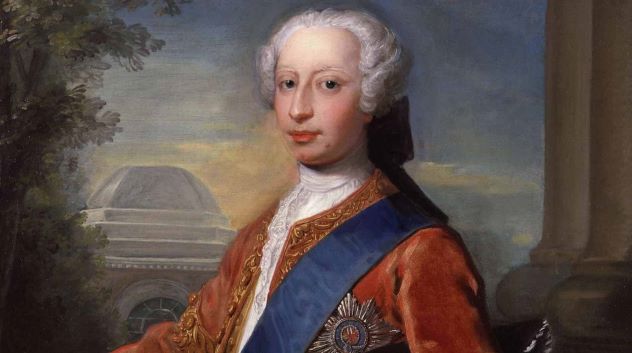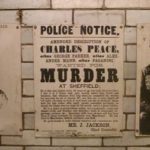 Movies and TV
Movies and TV  Movies and TV
Movies and TV  Creepy
Creepy 10 Eerie & Mysterious Ghosts of the Pacific Coast
 Weird Stuff
Weird Stuff 10 Typos That Accidentally Changed History
 History
History 10 Times Trickery Won Battles
 Technology
Technology 10 Awesome Upgrades to Common Household Items
 Misconceptions
Misconceptions 10 Hilarious (and Totally Wrong) Misconceptions About Childbirth
 Weird Stuff
Weird Stuff 10 Warning Labels That Exist Because Someone Actually Tried It
 Health
Health Ten Confounding New Inventions from the World of Biomedicine
 Creepy
Creepy 10 Death Superstitions That Will Give You the Creeps
 Movies and TV
Movies and TV 10 Movies That Get Elite Jobs Right, According to Experts
 Movies and TV
Movies and TV 10 Most Realistic Medical TV Shows of All Time
 Creepy
Creepy 10 Eerie & Mysterious Ghosts of the Pacific Coast
 Weird Stuff
Weird Stuff 10 Typos That Accidentally Changed History
Who's Behind Listverse?

Jamie Frater
Head Editor
Jamie founded Listverse due to an insatiable desire to share fascinating, obscure, and bizarre facts. He has been a guest speaker on numerous national radio and television stations and is a five time published author.
More About Us History
History 10 Times Trickery Won Battles
 Technology
Technology 10 Awesome Upgrades to Common Household Items
 Misconceptions
Misconceptions 10 Hilarious (and Totally Wrong) Misconceptions About Childbirth
 Weird Stuff
Weird Stuff 10 Warning Labels That Exist Because Someone Actually Tried It
 Health
Health Ten Confounding New Inventions from the World of Biomedicine
 Creepy
Creepy 10 Death Superstitions That Will Give You the Creeps
 Movies and TV
Movies and TV 10 Movies That Get Elite Jobs Right, According to Experts
10 Rogue Princes from British History
It may shock you to learn that giving a young man a huge amount of money, privilege, and social notoriety does not always bring about a well-adjusted adult. Princes in monarchies are given all this, plus a huge amount of responsibility and constant fear that they will cause scandal. But how are they to spend their time when their entire job is essentially waiting around to see if someone dies and they get to be king? At the moment, one particular British prince is going rogue and revealing the pressures all princes feel, while another has “retired” after a very public sex scandal involving human trafficking.
Here are ten times British princes did things worse than writing a tell-all book.
Related: 10 Of The Most Unflattering Nicknames Given To Royals
10 Prince Albert Victor
Prince Albert Victor (1864–1892), Duke of Clarence and Avondale, was the oldest son of Queen Victoria’s heir Prince Edward. Despite, or perhaps because of, the queen’s strict moral expectations of her family, several of them went rogue and became embroiled in scandals. Prince Albert Victor was one of the most eligible bachelors in Europe, yet there was something about him that put off prospective brides. Princess Alix turned him down to marry Tsar Nicholas II—a marriage that ended with the Russian royals being murdered. Perhaps it was his affection for several other women which put her off? He was supposedly involved with a chorus girl. A mysterious illness Albert Victor suffered has been suggested by historians to have been gonorrhea.
Albert Victor did not keep his romancing to just women, it seems. There are hints that he was bisexual. In 1889, the London police raided a male brothel on Cleveland Street. When the rent boys began naming their illustrious clients, one of the lords caught up in the scandal hinted he would reveal a member of the royal family as a patron unless he was let off. The initials of that royal were P. A. V.—Prince Albert Victor.
Albert Victor died in 1892 of pneumonia. However, his death did not stop the gossip about him. One historian has suggested he may have been Jack the Ripper.[1]
9 Dirty Bertie
Albert Victor’s father, Prince Edward (1841–1910)—later King Edward VII—was no stranger to scandal. As heir to the famously long-lived Queen Victoria, he found he was given very little to do during his long wait to be king. So he turned to alcohol, smoking, gambling, and womanizing. The queen would blame her beloved husband Albert’s death on Edward’s wayward habits.
When he was found to be having affairs with women, the queen arranged a marriage. Married life did not slow him down, however. Edward loved Paris and, in particular, the ladies of Paris. A specially crafted chair with cushions, stirrups, and rests was designed and built for the portly prince to allow him to shift his bulk around as he made love. Known as Bertie to his family, Edward soon became known as Dirty Bertie to the world.
Much of this scandalous living went on behind closed doors, but in 1869, Edward was summoned to give evidence in a court case surrounding Harriet Mordaunt, where he was forced to testify that he had never had “improper familiarity” with her.[2]
8 The Prince Regent
George (1762-1830), the heir to George III, was described as a “bad son, a bad husband, a bad father, a bad subject, a bad monarch, and a bad friend.” He was obsessed with women and longed to be loved. He pressured those he was attracted to to give in to his desires. During an affair with Maria Fitzherbert, the prince threatened to commit suicide unless she agreed to marry him. Such a marriage would be illegal because she was a Catholic, and they had not sought the king’s permission. Nevertheless, the marriage went ahead in private.
The prince’s second, more public marriage came about because of the huge debts he ran up. Parliament refused to pay them off unless he got married. So he was betrothed to Caroline of Brunswick. It was not a success. On meeting her for the first time, he turned to a friend and said, “Harris, I am not very well, pray get me a glass of brandy.” George stayed drunk until his wedding and, that night, collapsed into the fireplace. Caroline left him there.
Their marriage was a never-ending disaster. When George was crowned king, he had the doors of Westminster Abbey slammed shut in her face.[3]
7 Prince George, Duke of Kent
Being the heir to the throne at least offers the hope of one day becoming a monarch. When you are the fourth son, you are not even the spare—you’re a spare to a spare to a spare. Prince George (1902–1942), Duke of Kent, was the son of king George V and is little known today, but he got up to a lot in his time as a royal. You don’t acquire the nickname the “Party Prince” for nothing.
George is rumored to have had affairs with people like the cabaret star Florence Mills, the playwright Noel Coward, and several socialites. His relationship with the son of the Argentine ambassador was apparently well-known. One of his lovers, Kiki Preston, was a fan of heroin and was known as “The Girl with the Silver Syringe.” She may have introduced George to the drug.
Prince George died in a plane crash during the Second World War.[4]
6 Prince William
When George IV’s daughter Charlotte died during childbirth, it left the British royal family in crisis. Although George III had fathered 15 children, none of them had produced a living, legitimate grandchild. Unless George IV’s siblings could produce an heir, the House of Hanover would go extinct. This caused a race among his brothers, who all married hastily to get a legitimate heir.
Prince William (1765–1837), the later King William IV, must have expected that he would win this race. After all, he had fathered ten children with his long-term mistress, the actress Mrs. Jordan. Mrs. Jordan was a sensation on the stage, and despite society casting scorn on her private life, she continued to be one of the most sought-after actresses of the age. As her name, Jordan, was also used for chamberpots, many hostile cartoons of the prince were made where he was shown climbing into a suggestively shaped crack in a chamberpot. The prince and Mrs. Jordan lived together happily with their family.
When forced to marry a legitimate wife, William put Mrs. Jordan away with a pension on the condition that she never appear on stage again. In order to pay off her son’s debts, Mrs. Jordan had to earn money by acting. For breaking their deal, William took their daughter away and canceled all money to his former mistress.[5]
5 Robert Curthose
While most rogue princes today will do nothing but cause a little embarrassment, things in the past could get a little more bloody. William the Conqueror could be a bit rough—his Harrying of the North campaign against the north of England has been compared to genocide. So Prince Robert (c 1050–1134) got off lightly when his dad nicknamed him Curthose, meaning “short trousers.” His brothers also got in on the act. When they thought Robert was getting a bit too big for his boots, they dumped the smelly contents of a chamberpot over his head. Robert did not take this well.
Robert started a rebellion when he felt his father had not sufficiently punished his brothers for their prank. With his friends, he went off and attacked Rouen castle. Their attack failed, so Robert fled, but King William came after him with an army. Robert allied with another nobleman to create havoc, so William allied with the king of France to bring down his rogue son.
Still, when William died, he left his lands in Normandy to Robert. Robert later rose up in rebellion against his brother, who had been made king of England.[6]
4 Ernest Augustus
In 1810, Prince Ernest Augustus (1771–1851), son of George III, was asleep in his bed when he was woken by someone savagely beating him about the head. He did not see anyone in the room, but as he moved to the door to seek help, he received a saber cut to the leg. The prince ordered his household sealed so that the attacker could not escape. When a search was done, his valet, Joseph Sellis, was found dead. His neck had been slashed open in an apparent suicide. Sellis had attacked the prince and then killed himself. That, at least, was the official version.
Several papers at the time speculated on the real events of the evening. Had Sellis been outraged that the prince was making advances on his wife? Had the prince faked the attack to hide his murder of his own valet? Had another servant murdered Sellis and faked the attack to frame him? All were considered. A book was published in 1832 which said Ernest had killed Sellis to hide the prince’s gay affair with another servant. The author was found guilty of libel.[7]
3 Frederick, Prince of Wales

The United Kingdom has never had a King Frederick, but it came close in the 18th century. Frederick was the son and heir of George II. No one was happier than the king, however, when Frederick (1707–1751) died before he could inherit the throne. Even Frederick’s mother had been heard to comment that he was “the greatest ass and the greatest liar and the greatest canaille and the greatest beast in the whole world” and “I heartily wish he were out of it.” On another occasion, she wished that the earth would open up and swallow her son so that she would no longer have to deal with him.
His “crimes” against his parents were that he refused to toe the line they set in politics. He courted the opposition politicians of the day and set up what amounted to a rival court in his own palace. Because of the rupture in the royal family, the king refused to grant Frederick the money he needed to cover his lavish expenses. So Frederick appealed directly to Parliament. Those who were not fond of the king loved this animosity.
When Frederick died, supposedly because he was struck by a cricket ball, few people were invited to the funeral.[8]
2 Prince Frederick, Duke of York
Prince Frederick (1763–1827), Duke of York, was the second son of George III. During the Napoleonic wars, Frederick was made commander-in-chief of the army. Perhaps his most lasting epitaph is the children’s rhyme written for his unimpressive military campaign.
“The grand old Duke of York,
He had ten thousand men.
He marched them up to the top of the hill
And he marched them down again.”
The Duke of York became embroiled in a scandal involving his mistress Mary Anne Clarke. The prince had agreed to pay a pension to Clarke when they separated but later stopped payment. To make money, she began to sell appointments in the army, apparently under his agreement. A parliamentary commission found the duke innocent, but he was forced to resign his position. Clarke was paid £10,000 and given a yearly settlement to burn the Duke’s letters and a memoir she had written.[9]
1 Henry, the Young King
Today, the worst that happens when royals do not get along is that they brief negative stories to the press. Henry II had more problems than that with his sons. Henry II decided to make the line of succession obvious by crowning his son, also called Henry, while he was still alive. This young king Henry (1155–1183) was eager to get his hands on some of the domains he was due to inherit—his father was less willing to give them up. When the king gave three castles to his favorite son, John, the young king rebelled.
Egged on by his mother, Eleanor of Aquitaine, Henry, with his brothers Richard and Geoffrey, fled to Paris to ally with the French king and raise armies. The princes had a good chance of unseating their father, but Henry II was a military genius and crushed all the forces arrayed against him. The rebellious sons were pardoned, but Eleanor remained closely guarded while Henry II lived to ensure she did not spark another war. The young king never got to be a real king. He died of dysentery six year before Henry II.
It makes today’s royal squabbles look tame by comparison. [10]








